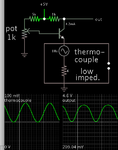abdoalghareeb
Member level 5

this is my design for Thermocouple K-type amplifier
The output (TC) of amplifier circuit is connected to ADC0 PORT of ATMEGA8L
At first : To calibrate the amplifire (LT1012) I remove the microcontroller then I short the Thermocouple input to ground , then I adjust the offset
potentiometer(R1) to make the output of amplifier circuit equal zero .
now I insert the microcontroller and the problem appears here , about 100 mv appears on ADC0 port (it should be stay zero).
Why does this millivolt appear?

The output (TC) of amplifier circuit is connected to ADC0 PORT of ATMEGA8L
At first : To calibrate the amplifire (LT1012) I remove the microcontroller then I short the Thermocouple input to ground , then I adjust the offset
potentiometer(R1) to make the output of amplifier circuit equal zero .
now I insert the microcontroller and the problem appears here , about 100 mv appears on ADC0 port (it should be stay zero).
Why does this millivolt appear?



